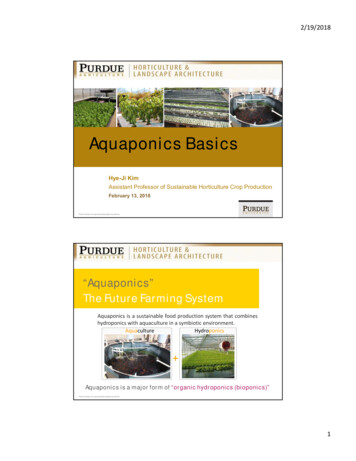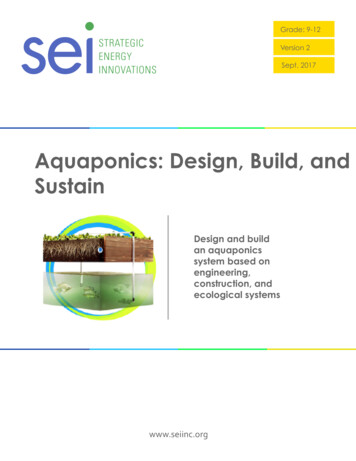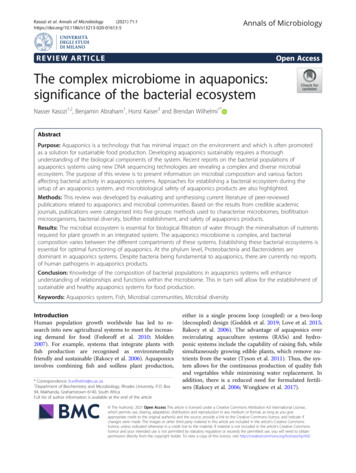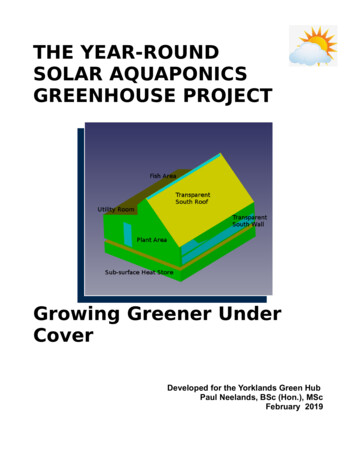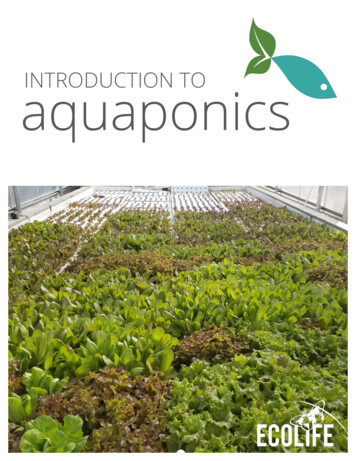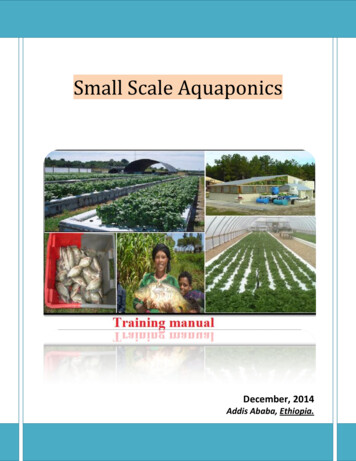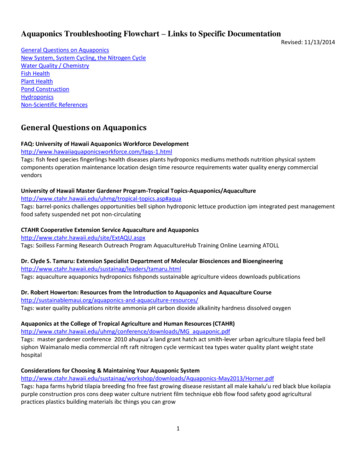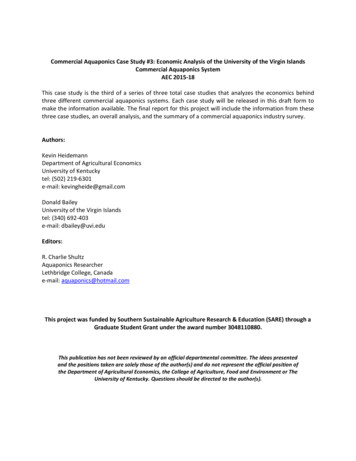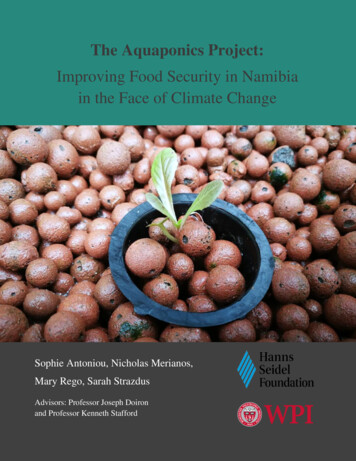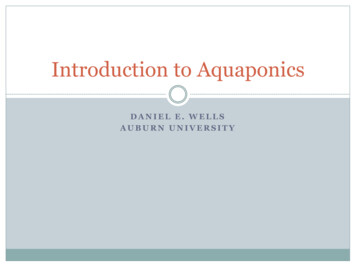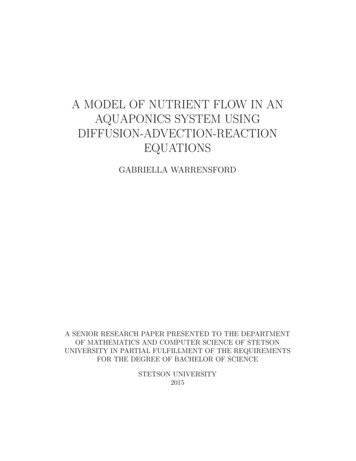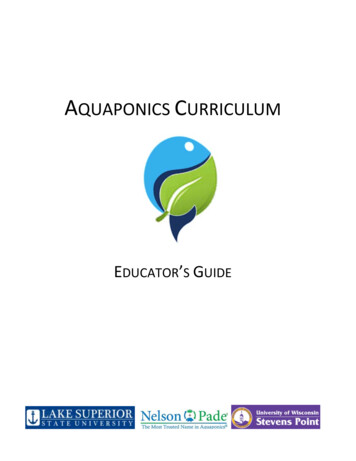
Transcription
AQUAPONICS CURRICULUMEDUCATOR’S GUIDE
AQUAPONICS CURRICULUMTable of ContentsCHAPTERUNIT NUMBER TOPIC112Introduction & History of AquaponicsEstablishing and Maintaining the Fish TankPAGE727NELSON ANDPADE,3Seed Germination and Planting404Plant Selection and Care495Plant Nutrient Requirements6Photosynthesis, Transpiration and Light687Fish Anatomy768Fish Nutrition and Health869Plant Physiology & Light95Additional10Fish Anatomy and Physiology109Curriculum11Water Quality & Chemistry131INC. 2UWSPItemsAppendix AAppendix BAppendix CAppendix DAdditional Information Sources andPertinent WebsitesProject and Experimental IdeasOther Products from Nelson/PadeMultimediaArgument Driven Approach Rubric58150152153154
AQUAPONICS CURRICULUMGRADES 7-12CHAPTER 2BIOLOGY DEPARTMENTUNIVERSITY OF WISCONSIN-STEVENS POINTCBB 302STEVENS POINT, WI 54481
PLANT PHYSIOLOGY& LIGHT9ESSENTIAL QUESTIONS:1. What is the role of oxygen on the uptake ofwater and minerals?2. How does transpiration in plants influencefish health in an aquaponic system?Light & PhotosynthesisPhoto credit:Northern Aquaculture Demonstration FacilityTranspirationLEARNING OUTCOME(S): Use a model to illustrate howphotosynthesis transforms light energy intostored chemical energy. Use mathematical representations tosupport claims for the cycling of matter andflow of energy among organisms in anecosystem.LEARNING OBJECTIVES:1. Evaluate the role of oxygen on the uptake ofroot water and mineral nutrients.2. Review of photosynthesis and respiration.3. Draw connections between root to shootratios and nutrient requirements of plants.4. Analyze the role of transpiration and how tocalculate a water transpiration budget andhow much make-up water would need to beadded to the fish tanks.NEXT GENERATION SCIENCE STANDARDS(NGSS):LS1LS2LS4From Molecules to Organisms: Structure& ProcessesEcosystems: Interactions, Energy, andDynamicsBiological Evolution: Unity and DiversityESS2 Earth’s SystemsESS3 Earth and Human ActivityPS1 Matter and its InteractionsPS3 EnergyPS4 Waves and their application intechnology for information transferETS2 Links among Engineering, Technology,Science, and Societyneed moisture, proper temperature and humidity togerminate. Germination times range between one day and morethan a month, depending on the type of plant. Lettuce, bean andpea seeds all germinate rapidly, in a day or two. Tomato andcucumber seeds germinate in 2-4 days.Although it is possible to seed directly into the aquaponic growbed, we suggest you set up a separate table for germination.Many growers use a simple flood and drain table, where thewater from a reservoir floods the media that the seeds areplanted in and then the water drains back to the reservoir. Thisflood and drain action flushes the media with fresh water andnutrients and then, as it drains away, fresh air is drawn into thecubes. This provides an ideal ratio of water, nutrients andoxygen to the seeds in the media.The seeds and the space they need for germination is very small,so germinating them in the grow bed is not an efficient use ofthat space. Once a seedling is 2-3 inches tall, it can be spread outor transplanted into the grow bed. Some growers will transplantthe seedlings several times, each time giving the plant morespace. This results in the best utilization of the space you have,but requires more labor and handling of the plant.
To germinate seeds that will go into a soilless aquaponic system, mostgrowers will place the seeds in an inert growing medium, such asrockwool or perlite. Other materials that are used include peat moss,a peat moss and vermiculite mix, and coconut coir, which is theshredded husk of coconuts. Ideal mediums are chemically inert,porous, clean, free of contaminants and able to drain freely.The initial stages of plant growth happen within the seed coat. As theseed absorbs water, growth begins with cell enlargement. In thepresence of water, the stored reserves within the seed are convertedchemically to substances that can be readily used in the growingprocess. Once the seed coat breaks and the radicle emerge, theseedling will need to draw moisture and nutrition from the mediumSHOOT stems & rootsROOTS anchor the plant collect nutrientsSTEMS provide supportfor the leaves (siteof photosynthesis)surrounding it. The seed itself carries enough nutrients for thegermination and the first couple of days of growth. After that, nutrients need to be provided so theplant can grow. Once the first green leaves, the cotyledons, are visible light will be required. If properlight is not provided, a plant will grow tall and spindly; this is often referred to as “stretching.” Youngplants will quickly do this without adequate levels of light.The concept of continuous production in the raft system is to always transplant your seedlings at oneend of the raft tank and harvest the mature plants at the other end. The rafts are pushed ahead asrafts with new seedlings are placed in the seedling end, just after mature heads have been removedfrom the harvest end.Plants are comprised of major zones that are responsible for specific tasks. Roots anchor the plantand collect water and nutrients. Stems provide support for the leaves which is the primary site forphotosynthesis. Collectively, stems and leaves are called the shoot.
9The roots serve to anchor the plant into soil or a grow media, but above all they absorbwater that is required by the plant for photosynthesis and transpiration. Waterabsorption occurs mainly in the younger roots or root hairs that expose a tremendousamount of surface area for absorption. Water moves through the roots and into thestem by root pressure. With a high-water potential in the roots and lower waterpotential in the leaves due to transpiration, water moves by osmosis from the roots tothe leaves. The water also carries inorganic nutrients that enter into the roots by activetransport. Since nutrients are large molecules, energy is required during root absorptionof inorganic nutrients. Once the nutrients are in the plants roots, they are transportedby xylem vessels to the leaves.While water and inorganic nutrients ascend the plants to the leaves, sugarsmanufactured during photosynthesis move out of the leaves in the assimilate stream ofthe phloem. The sugars are transported to sites in the plant where they are used, suchas growing shoots and roots, but are also sent to sites of storage, such as fruits, seeds,roots and stems.As the seed embryo develops there is initially a flow of nutrients from the parent plantto the ovule resulting in a buildup of food reserves within the endosperm. Eventually,the ovule becomes a nutritionally closed system and the seed desiccates as it loseswater and the seed coat hardens forming a protective armor. The mature embryoconsists of one or two cotyledons, which are the seed leaf and often become the firstleaves of the plant upon germination. If the embryo has one seed leaf it is called amonocot, such as corn or onions, and if it has two seed leaves it is called a eudicot, suchas beans. There is also the epicotyl, or stem above the cotyledons that will eventuallydevelop into the leaves, the plumule or first bud of the plant, the hypocotyl which is thestem located below the cotyledons, and the radicle that will develop into the root.PLANT PHYSIOLOGY & LIGHTFigure 1: Anatomy of a plant
Germination, or the resumption of growth of the embryo, is dependent on external and internalfactors. These factors differ for different plant seeds but external factors can include water, oxygen,temperature and light. Internal factors are triggered by the external factors and this results in theactivation of enzymes and a somewhat reversal of what happened when the seed was forming. Thestored food in the seed is digested, the cells divide and after the seed imbibes water, it swells, andthe seed coat cracks open.Figure 2: Process of germination.When germination occurs, the first structure to emerge from most seeds is the root or radicle. Thisallows the seedling to become anchored in the soil or grow media and absorb water. From here, itdepends on the species of plant. In some plants, the hypocotyl emerges from the seed bentprotecting the shoot tip. Once above ground the coytledons and plumule are pulled into the air. Thistype of seed germination is called epigeous.In other plants, the epicotyl elongates and forms the bent hook. As it straightens out the plumule israised above ground or above the grow media’s surface. The cotyledons never emerge above thesurface. This type of seed germination is called hypogeous.
From here, an orderly sequence of leaves and axillary shoots develops into the full plant.Germination and the development of the embryo into a plant is the most crucial phase in a plantsdevelopment and is when the plant is most susceptible to injury from disease, insect pests and fungi.ACTIVITY 9: SEEDING, DEVELOPMENT & TRANSPLANTINGACTIVITY LEARNING OBJECTIVES: Observe differences in germination rates and development with seeds planed in differentmedia.Observe prepared microscope slides, or online /Chap12/Chapter 12A.html), to show early celldevelopment, embryogenesis, cell division and organogenesis.Practice transplanting seedlings from the germination tray to the raft, NFT and media beds.NGSS PRACTICES:1. Asking questions2. Conducting Investigations3. Analyzing Data4. Using Mathematics5. Constructing Explanations6. Communicating InformationESTIMATED TIME:Discussion: 30 minutesActivity: 30 minutesObservations: Several DaysACTIVITY OBJECTIVES:MATERIALS (FOR ACTIVITIES 2-4) Variety of media (rock wool, sand,gravel, perlite, clay balls, coconut coir)plastic net cupsseeds of monocots and eudicotsseeding sticksprepared slides of early plantdevelopmentaerator with air stonecelery food coloringplastic cupknifeplastic bagstwist-tiesrulersbalance
DIRECTED INSTRUCTIONS:1. Place seeds in a variety of media in a germination table and observe differences ingermination and early plant development. For example, media may consist of rock wool, sand,gravel, perlite, clay balls, and coconut coir.2. Qualitatively describe root and shoot formation based on density and porosity of media. Note:some loose media may require net pots (https://aquaponics.com/store2/2-net-pots/).3. Over several days observe and document plant development comparing prepared slides oronline pictures to live seedlings. If microscopes are available, view early stages of plantdevelopment including radicles, cotyledons, epicotyl and hypocotyl.4. Discuss role of each part including nutrient reservoirs, first emergence (epigeous andhypogeous) and initiation of photosynthesis.5. After 1-2 weeks, transplant the seedlings from the germination tray to the grow bed. This is agood time to take notes on plant development, maturation and health. While you may haveonly one type of grow bed, typically a raft or deep-water culture, take the time to discussother types of grow bed systems such as raft (DWC), nutrient film technique (NFT) and mediabeds.6. Discuss the type of plant you can grow in each grow bed, nutrient uptake and plantarchitecture.Generate a table that compares and contrasts the differences in transplanting and selection of a growbed such
Table 13. Comparison and contrast between grow bedsGrow BedRaft1AdvantageDisadvantageNutrient uptakeConstant water flowBiofilter may be neededHighSmall sump neededLarge volume of waterEasy maintenance &Root aeration t uptakeFilmConstant water flowBiofilter neededLowTechnique2Small sump neededLower yieldSmaller water volumeLess system stabilityMedia-AdvantageDisadvantageNutrient uptakebasedBiofiltration in mediaLarge sump neededHighSolids filtered in mediaMaintenance & cleaningdifficultMineralization in grow bedClogging can lead tochannelizationACCOMMODATIONS & GRADE/LEVEL DIFFERENTIATION:Provide students with illustrations and written directions. Allow students more time to devisetheir experiment (e.g. assign experimental design as a homework assignment). Provide diagramsof the germination process, photosynthesis and plant anatomy.
ACTIVITY 10: PLANT PHYSIOLOGYACTIVITY LEARNING OBJECTIVES:1. Evaluate the role of oxygen on the uptake of root water and mineral nutrients. Review ofphotosynthesis and respiration.2. Observe water and nutrient movement as seen through Water-Movement-Within-Celery/) to show xylem andphloem tissue and capillary action.3. Compare root to shoot ratios and evaluate how they indicate nutrient requirements of plants.4. Describe the role of transpiration and calculate a water transpiration budget and how muchmake-up water would need to be added to the fish tanks.5. Recognize the basic procedures of photosynthesis, transpiration and the influence of lightspectrumsNGSS PRACTICES:1. Asking questions2. Conducting Investigations3. Analyzing Data4.5.6.7.Using MathematicsConstructing ExplanationsCommunicating InformationArguing from EvidenceMATERIALS: Grow bed with actively growing plantsAirstoneCeleryFood coloringPlastic cups3 plastic bagsScaleTwist tiesVariety of lighting condition (The source of the light can come from the sun (if thegarden is near a window or in a green- house), fluorescent, incandescent, metalhalide or high-pressure sodium lights. Light levels can be increased by use of a lightreflectorDIRECTED INSTRUCTIONS:Exercise 1: Aeration of the roots is important for plants to uptake water and mineral nutrients.
1. To test this, using a raft grow bed, fix an airstone to the bottom of the grow bed sothat only some of the plant roots are coming into direct contact with the airbubbles.the maximum shoot height and leaf canopy width, and the length of the roots.3. Plot the growth of the plants based on average length & number of each variableover the course of time for plants directly and indirectly in contact with the airbubbles.Exercise 2: Differences in xylem and phloem tissue can be seen by performing a simpleexperiment with celery. While you can use celery, you may be growing in your aquaponicssystem, the experiment works fine with previously harvested, store bought celery (wholenot hearts).1. Using a knife, cut the celery into 3 pieces about 6 cm long. Each piece should be cutdifferently (e.g. 1. Include leaves, 2. Cut evenly on both ends, 3. Cut unevenly withPLANT PHYSIOLOGY & LIGHT2. Over the course of a few weeks count the number of leaves on each plant, measure9some of the skin of the celery separated from the rest of the celery).2. Measure ¼ cup water into a clear plastic cup3. Add three drops of food coloring into the cup filled with water. Mix.4. Place the celery in the cup of water vertically so that only one end of the celery is inthe water.5. Allow celery to sit for at least 6 hours.6. Make observations.Exercise 3: Roots allow plants to absorb water and mineral nutrients from the water and ahealthy root system is the key to a healthy plant. The root:shoot ratio is one measure toassess the overall health of your plants. A healthy plant should have an even balance ofroot and shoot biomass (close to 1:1). Any deviations from this (either up or down) wouldbe an indication of a change in the overall health of your plant. It is important to combinedata from the root:shoot ratio with data from observations to get an accurateunderstanding of what is happening to the plants. For example, an increase in root:shootratio could be an indication of a healthier plant, provided the increase came from greaterroot size and not from a decrease in shoot biomass. Overall, long roots and short shootssuggest a plant is searching for nutrients in a nutrient poor environment while long shootsand short roots indicate adequate growth and nutrient .In aquaponics, water loss not only occurs from evaporation from the fish tanks, but alsothrough plant transpiration. A corresponding and appropriate amount of “make-up” watermay need to be added to the system daily. This water should be of proper quality and consistency
with the current water in the system (i.e. not chlorinated, equal temperature, pH, etc). To betterunderstand the potential water loss due to transpiration, this simple experiment can be conducted.1. Take three plastic bags, label and weigh each in its empty state.2. Place one bag each on the plants in the raft grow bed. The bag should be placed looselyover the plant but use a twist-tie to wrap the bag about the base of the stem of the plantsecurely, thereby, closing the bag.3. Wait 1 hour (if sunny, 2 hours if cloudy), then gently remove the bag from the plant, whichmay require tilting the plant, being careful not to allow any water in the bag to drip out.4. Reweigh the bag with the water contained within. The weight difference between theempty plastic bag and the bag with the condensation will be the transpiration amount(grams of water per hour).5. Calculate water transpiration budget by multiplying the amount of water transpired perhour for the plant you measured, times the total number of plants in your grow bedsystem, times the number of hours of daylight. Water loss due to transpiration is greatlyreduced at night when the plants respire. This calculation should provide you with anestimate of the amount of make-up water that would need to be added daily to the fishtanks due to transpiration alone. To make the estimate slightly more accurate, you candouble or halve the transpiration amount based on the size of the plants in the systemcompared to the size of the plant you actually measured.EXTENSION ACTIVITY:Compare sugar production by different plants in your system. Ifyou recall, photosynthesis is the process of converting the sun’slight into chemical energy and storing this energy in the bondsof sugar. This sugar ultimately forms the building blocks for fats,proteins starches, cellulose, etc. To measure the amount of sugar in a plant we will use a tool knownas a refractometer. A refractometer measures the amount of sugar as degrees of Brix. High levels ofbrix can be used as a proxy for higher rates of photosynthesis. To conduct this test, you need a fewdrops of juice from the leaves of your plant. Place this liquid into the refractometer and hold it up tothe light. The light passing through the liquid will refract (bend) based on the contents of the liquid(how many dissolved solids such as sugar, minerals, proteins, etc.). Record your reading in degrees ofBrix.
Refractive index of select plants - - calibrated in % sucrose of BrixQUESTIONS FOR DISCUSSION:1. Describe the process of transport through the celery plant. Discuss the action and role ofcapillary action.2. Discuss the role of air in the uptake of water and mineral nutrient movement by osmosis andactive transport.ACTIVITY GUIDELINES/TIPS:A review of photosynthesis and respiration should precede these exercises (See review/assessmentthat follows).
UNIT 9: PHOTOSYNTHESIS AND CELLULAR RESPIRATION ASSESSMENT/REVIEWChloroplastsPhotosynthesis is a process in which sunlight energy is used to make glucose. The site ofphotosynthesis is in the chloroplast – an organelle found in the leaves of green plants. The mainfunctions of chloroplasts are to produce food (glucose) during photosynthesis, and to storefood energy. Chloroplasts contain the pigment, chlorophyll. Chlorophyll absorbs most of thecolors in the color spectrum and reflects only green and yellow wavelengths of light. This is whywe see leaves as green or yellow – because these colors are reflected into our eyes.Plant Cell1. What is photosynthesis? Process by whichplants make their own food (glucose) andproduce oxygen2. Where does photosynthesis occur? In theleaves of plants in structures calledchloroplasts3. What are chloroplasts and where are theyfound? Organelles found in the leaves ofgreen plants4. What are the two main functions ofchloroplasts? To produce glucose and foodenergy5. Why do most leaves appear green? Becauseof the pigment chlorophyll found in thechloroplast6. What is the primary pigment found in the chloroplast? ChlorophyllPhotosynthesisGlucose is another name for sugar. The molecular formula for glucose in C6H12O6. Plants makesugar by using the energy from sunlight to transform CO2 from the air with water from the15
ground into glucose. This process, called photosynthesis, occurs in the chloroplast of the plantcell. During this process, oxygen (O2) is created as a waste product and is released into the airfor us to breathe. The formula for photosynthesis is:CO2 H2O sunlight ---- C6H12O6 O2This formula says that carbon dioxide and water molecules are combined with the energy fromsunlight to produce sugar and oxygen. The reactants in photosynthesis (what is used) are CO2,water and sun. The plant gets water from the ground through its roots. The plant collectscarbon dioxide from the air. Much of the carbon dioxide comes from living organisms thatexhale it, but some also comes from factory smokestacks and car fumes.7. What is the formula for photosynthesis?CO2 H2O sunlight ---- C6H12O6 O28. What three things are used to make glucose in photosynthesis?Light energy, carbon dioxide, and water9. Where does the water come from? From the ground10. Where does the water enter the plant? Roots11. What are some sources of CO2? living organisms, smokestacks,and car fumes12. What type of energy does the plant use to convert CO2 and H2O into sugar?Light energy13. What two major plant processes require light:The products (what is made) are glucose and oxygen. The glucose produced is used bythe plant for energy and growth. We also use this glucose by eating plants. The oxygen16
produced is released into the air for us to breathe. Photosynthesis is essential for all lifeon earth, because it provides food and oxygen.14. What is produced in photosynthesis? Glucose and Oxygen15. What is the glucose used for? Energy and growth16. What is the oxygen used for? For living organisms to breatheCellular RespirationRespiration is the cellular process in which glucose breaks down into water and carbon dioxideand releases energy.Glucose OxygenCarbon DioxideC6H12O6 6O26CO2 water6H2O Energy (ATP)Energy (ATP)Respiration can occur without light because energy is stored in carbohydrate molecules.Respiration occurs in both plant and animal cells in structures called mitochondria.TRUE/FALSE17. The transpiration process stores energy for other plant processes.True /False18. Photosynthesis takes place in the chloroplasts within the leaf tissue.True / False19. The orange rays are the longest rays of sunlight.True / False20. Incandescent light is very effective for plant growth. True /False21. List the four primary types of supplemental light:a. incandescent17
b. fluorescentc. metal halided. high pressure sodium1. What is cellular respiration? Cellular process in whichglucose is broken down into carbon dioxide and water,and energy is released2. Where does cellular respiration occur? Occurs in bothplant and animal cells in structures called mitochondria3. What is the formula for cellular respiration?6CO2 6H2O Energy(ATP)C6H12O6 6O24. What are the products of cellular respiration? Carbondioxide, water and ATP energy18
10FISH ANATOMY &PHYSIOLOGYEssential Question:1. What is the external and internal anatomy ofa fish and how does this compare to humananatomy?FISH ANATOMYFEEDING CALCULATIONSLEARNING OUTCOME(S): Develop and use a model to illustrate thehierarchical organization of interactingsystems that provide specific functionswithin multicellular organismsLEARNING OBJECTIVES:1. Understanding the internal organs andsystem functions of a local fish species2. Understand the external body parts of fish3. discuss both internal and external featuresin relation to the human anatomy.4. Identify 3-5 external anatomical features ofa fish.5. Identify the major internal organs of a fish.6. Compare and contrast human and fishinternal organs, structures, and systems.NEXT GENERATION SCIENCE STANDARDS(NGSS):LS1LS2LS4From Molecules to Organisms: Structure& ProcessesEcosystems: Interactions, Energy, andDynamicsBiological Evolution: Unity and Diversityquaponic systems must operate near maximumfish production capacity, also called loading density, tobe economical. Therefore, fry or fingerlings should bestocked at very high rates at around 30 fish per cubicfoot. Feeding rates should be at optimum for rapid fishand plant growth while also making sure not tooverfeed.Loading density, or carrying capacity, is the number orbiomass of fish an aquaponic system can support. In arecirculating system, the loading density depends onwater flow, volume, exchange rate, temperature,dissolved oxygen, pH, size and species of fish, and theaccumulation of metabolic waste. Since dissolvedoxygen is affected by temperature, is directly related tometabolism, its quantity is a function of water volume,and its regeneration is dependent on the waterexchange rate, it is often used as the limiting factorwhen determining loading density. But the general ruleis that whatever the limiting factor is, it is used todetermine the loading density of fish in the system.The loading density of a system is usually stated as thepounds of fish per cubic foot of water. Catastrophic fishlosses can be caused by overloaded tanks and systemsand it is important to remember that the loading19
density needs to be continuously calculated as the fish grow since the biomass of fish isincreasing as they grow. But fish density can often be increased as fish size increases, yet this has to bebalanced against the fact that as density increases so may crowding of the fish which can affect their growthrate.There are a variety of ways to calculate the fish loading density for your system. Here we willcover two different methods. The first is based on the length of the fish and unit volume ofwater for the fish. One drawback to this formula is that the value Cdensity has only beendetermined for a few species of fish. The second method, can be applied to most any species offish, but has more factors you’ll need to enter. In the first equation, you need to know theaverage length of the fish you have and use the Cdensity value that was developed based on priorresearch. When measuring the length of a sample of your fish you should also calculate thestandard deviation of the sample. The length of all the fish you measure should not vary bymore than 10% from the average. If they do, this is indicative of over-stocking, under feeding,or other management problems and will provide an inaccurate value for the loading density.Ddensity L / CdensityWhere:Ddensity density in kg/m3 (mass of fish per unit volume)L average length of fish in cmCdensity (for tilapia 0.24); (for trout 0.32); (for perch 0.40)An example of loading density calculations for tilapia and trout would look like:TilapiaLength (cm) Weight ,8574,1671,9746.312.525.037.520
2.578.193.8109.4And, graphically it would be presented as:Number of fish per sh length (cm)354045In general, it is recommended that if you are raising tilapia in an aquaponic system the fishloading density should not exceed 60 kg/m3. This density has been shown to promote fastgrowth and efficient feed conversion and reduce crowding stress that may lead to diseaseoutbreaks. But it is based on a system where tilapia grow at a high density with consistentlygood water quality, higher water exchange rates, and vigorous aeration that provides DO thatstays at 5-6 mg/L.The formula for standard deviation (SD) is:SD square root [Sum (x – X)2 / (n-1)]Where:x numberX mean (average) of the numbersn number of numerical entriesHere is a second method for calculating loading rate. The amount of fish kept in the tank cannever be greater than the single limiting factor that is, the factor in short supply, that the21
system provides. Since ammonia is toxic to fish at low levels, we can use total ammonia in thisexample. The following formula is one way to calculate the density of fish that the system canhandle based on total ammonia nitrogen being the limiting factor.The formula is a two-step process. First, you establish what conditions are in your system andthen, you determine the density of fish that would push your system beyond safe limits fortotal ammonia nitrogen (TAN). For step one, determine the Ammonia factor for the fish tanksin the aquaponic system:Ammonia factor [(total ammonia) x (flow rate)] / (weight of food fed per day) Total ammonia in mg/LFlow rate in gallons per minuteWeight of food in pounds per dayRemember, if your aquaponic system has multiple fish tanks you must determine the averagetotal ammonia nitrogen among the fish tanks, the total flow rate (add together the flow to eachtank), and the total weight of fish food given to all the tanks daily. Once calculated, this is theAmmonia factor for the entire system.In this method, the loading density is based on the amount of fish food added to the systemdaily. Since the primary source of ammonia is the metabolism of food by the fish, there is acorrelation between the amount of fish food and the biomass of fish. So, in the second step tothis method you obtain from published scientific literature what the maximum tolerance levelof total ammonia nitrogen is for your fish (Note: this is TAN not just unionized ammonia). Then,you rearrange the previous formula to:Total ammonia [(weight of food fed per day) x (ammonia factor)] / (flow rate)Then you empirically calculate how
To germinate seeds that will go into a soilless aquaponic system, most growers will place the seeds in an inert growing medium, such as rockwool or perlite. Other materials that are used include peat moss, a peat moss and vermiculite mix, and coconut coir, which is the shred
